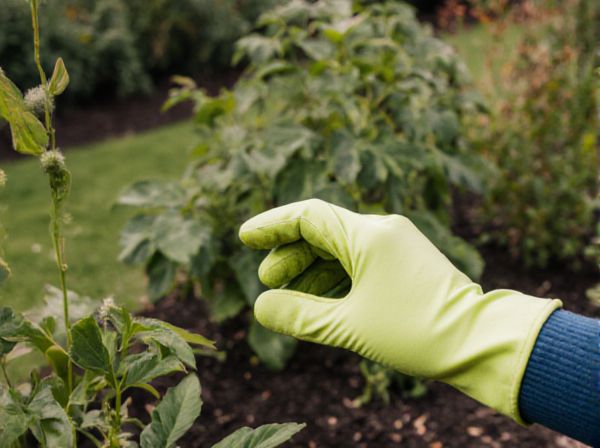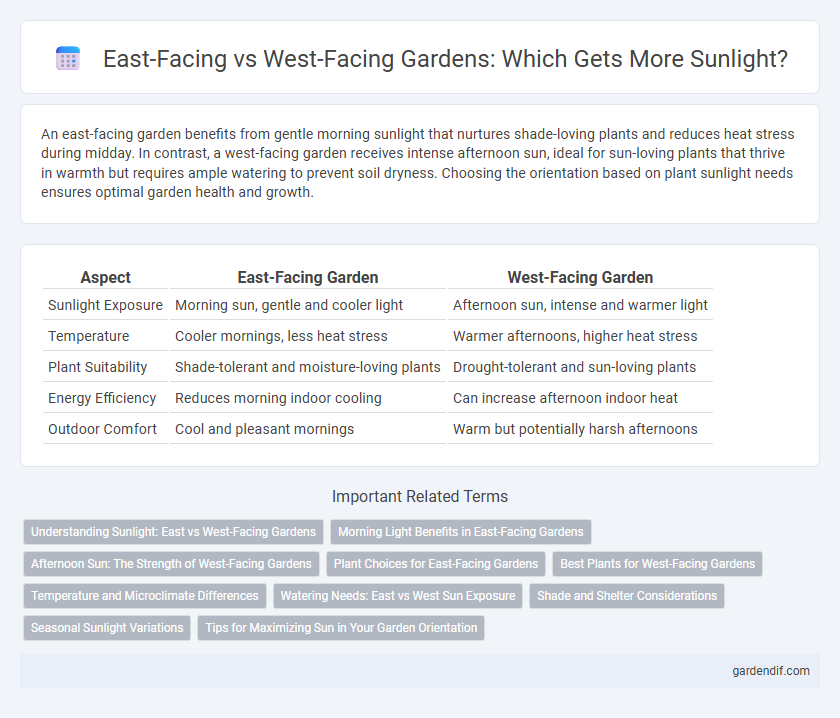
East-facing Garden vs West-facing Garden Illustration
An east-facing garden benefits from gentle morning sunlight that nurtures shade-loving plants and reduces heat stress during midday. In contrast, a west-facing garden receives intense afternoon sun, ideal for sun-loving plants that thrive in warmth but requires ample watering to prevent soil dryness. Choosing the orientation based on plant sunlight needs ensures optimal garden health and growth.
Table of Comparison
| Aspect | East-Facing Garden | West-Facing Garden |
|---|---|---|
| Sunlight Exposure | Morning sun, gentle and cooler light | Afternoon sun, intense and warmer light |
| Temperature | Cooler mornings, less heat stress | Warmer afternoons, higher heat stress |
| Plant Suitability | Shade-tolerant and moisture-loving plants | Drought-tolerant and sun-loving plants |
| Energy Efficiency | Reduces morning indoor cooling | Can increase afternoon indoor heat |
| Outdoor Comfort | Cool and pleasant mornings | Warm but potentially harsh afternoons |
Understanding Sunlight: East vs West-Facing Gardens
East-facing gardens receive gentle morning sunlight that promotes the growth of shade-loving and cool-weather plants, making them ideal for herbs and leafy greens. West-facing gardens experience intense afternoon sun, which benefits heat-tolerant and sun-loving plants like tomatoes and peppers but requires diligent watering. Understanding these sunlight patterns helps optimize plant selection and garden maintenance for healthier growth and higher yields.
Morning Light Benefits in East-Facing Gardens
East-facing gardens receive abundant morning sunlight that promotes healthier plant growth by providing gentle, cooler rays ideal for photosynthesis. This early light reduces the risk of leaf scorch compared to the intense afternoon sun in west-facing gardens. The consistent exposure to morning light enhances flowering and fruit development, making east-facing gardens highly beneficial for sun-loving plants.
Afternoon Sun: The Strength of West-Facing Gardens
West-facing gardens receive intense afternoon sun, often from 2 PM to sunset, providing a strong source of warmth and light essential for sun-loving plants like tomatoes, peppers, and sunflowers. This exposure encourages robust growth and flowering, making west-facing gardens ideal for gardeners aiming for vibrant, heat-tolerant landscapes. However, the intense late-day sun can increase water evaporation, necessitating thorough irrigation and mulching to maintain soil moisture.
Plant Choices for East-Facing Gardens
East-facing gardens receive gentle morning sunlight, ideal for shade-tolerant and moisture-loving plants such as ferns, hostas, and impatiens. These plants thrive in the cooler, less intense light and maintain vibrant foliage without the risk of leaf scorch common in harsher afternoon sun. Selecting species adapted to lower light intensity enhances growth, reduces water stress, and supports a lush, healthy garden environment.
Best Plants for West-Facing Gardens
West-facing gardens receive intense afternoon sunlight, ideal for heat-tolerant plants such as lavender, geraniums, and salvia, which thrive in warm, bright conditions. Succulents like aloe vera and sedum also flourish in west-facing gardens due to their drought-resistant nature and ability to withstand direct sunlight. Incorporating these species ensures vibrant blooms and healthy growth despite the stronger sun exposure later in the day.
Temperature and Microclimate Differences
East-facing gardens receive morning sunlight, resulting in cooler temperatures and a milder microclimate that supports moisture retention and reduces heat stress on plants. West-facing gardens are exposed to intense afternoon sun, creating higher temperatures and a warmer microclimate that can increase evaporation rates and require drought-tolerant plant species. These differences influence plant selection, watering frequency, and overall garden maintenance strategies based on sunlight exposure patterns.
Watering Needs: East vs West Sun Exposure
East-facing gardens receive gentle morning sunlight, leading to slower soil evaporation and reduced watering needs compared to west-facing gardens. West-facing gardens are exposed to intense afternoon sun, causing faster drying of soil and requiring more frequent watering to maintain plant health. Understanding sunlight patterns helps optimize irrigation schedules and conserve water efficiently in both garden orientations.
Shade and Shelter Considerations
East-facing gardens receive morning sunlight, making them ideal for plants that thrive in cooler, shaded conditions and providing natural shelter from harsh afternoon heat. West-facing gardens benefit from intense afternoon sun, requiring strategic shade elements such as pergolas or tall hedges to protect sensitive plants and create comfortable outdoor spaces. Understanding the sun's path helps optimize garden design for shelter, plant health, and user comfort.
Seasonal Sunlight Variations
East-facing gardens receive abundant morning sunlight, making them ideal for plants that thrive in cooler, gentler light, especially during spring and summer when early sun exposure is beneficial. West-facing gardens capture intense afternoon and evening warmth, supporting heat-tolerant species and extending the growing period into autumn due to prolonged sunlight. Seasonal variations affect sunlight angles and duration, with east-facing gardens favored for spring blooms and west-facing gardens providing optimal light for late summer and fall growth cycles.
Tips for Maximizing Sun in Your Garden Orientation
East-facing gardens receive gentle morning sunlight ideal for shade-loving plants and cool-weather vegetables, promoting healthy growth without heat stress. West-facing gardens capture intense afternoon sun, benefiting heat-tolerant plants like tomatoes and peppers but requiring strategic shading to prevent wilting. Utilize reflective surfaces, selective plant placement, and mulching to optimize sunlight exposure and soil moisture retention in both orientations.
East-facing Garden vs West-facing Garden Infographic

 gardendif.com
gardendif.com